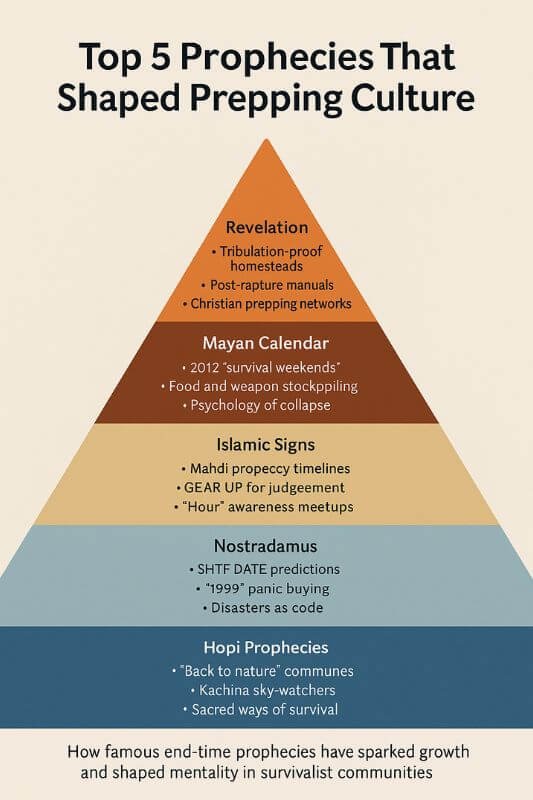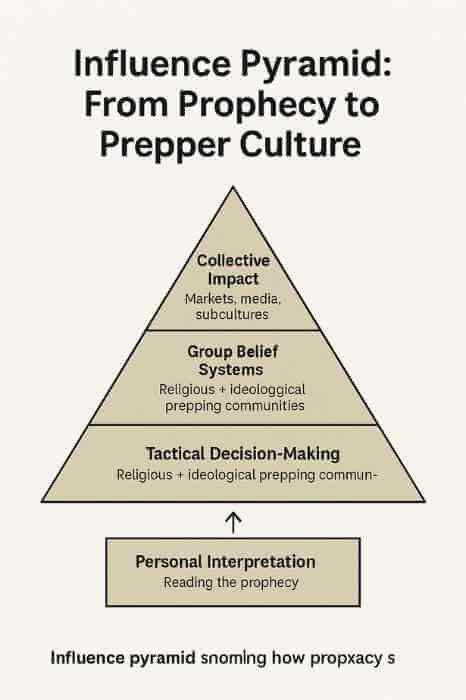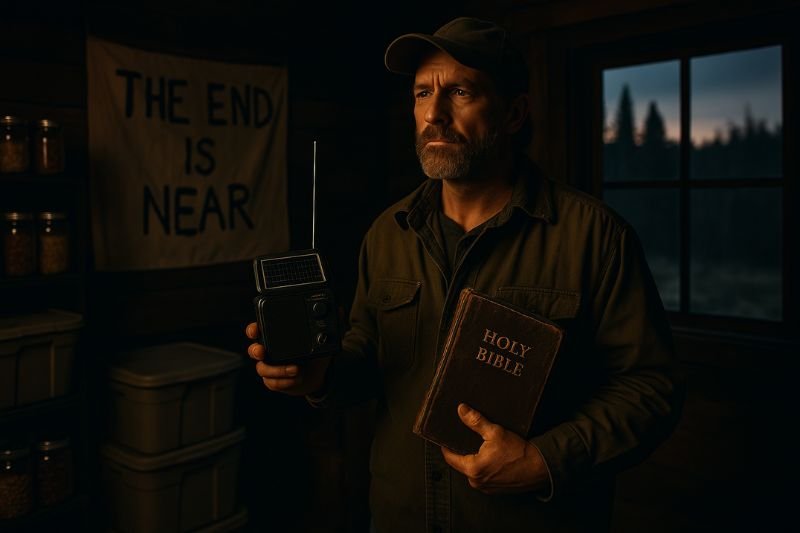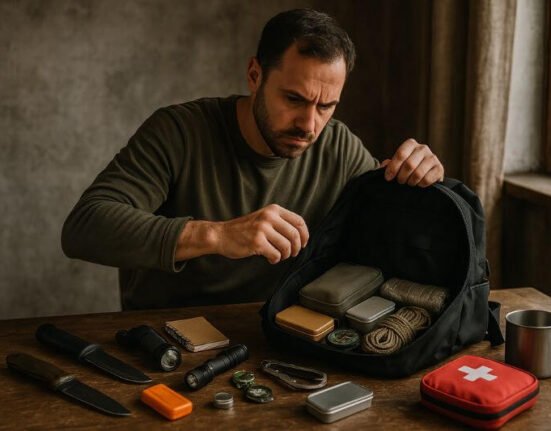From remote mountain bunkers to online prepping forums, survivalist movements around the world are shaped not just by politics or practical concerns—but by prophecy.
The impact of end-time prophecies goes far beyond religious belief. These ancient warnings have seeded entire ideologies, reshaped behaviors, and built subcultures grounded in the expectation of collapse. Whether drawn from Revelation, Nostradamus, or more recent eschatological visions, these prophecies fuel the strategies and motivations of millions who prepare not just for crisis—but for the end.
From Scripture to Strategy: How Prophecy Entered the Prepper Mindset
At the heart of most survivalist frameworks lies a question: what are we preparing for? While some answer with data—economic trends, geopolitical forecasts, or risk analytics—many point to prophecy. Not always religious. Not always literal. But always powerful.
Early Influence: Revelation and Rapture Culture
In the 1970s and 80s, particularly in the United States, the Book of Revelation became the spiritual backbone of what would evolve into Christian prepping. Bestsellers like The Late Great Planet Earth by Hal Lindsey, and later Left Behind, introduced a generation to the idea that prophecy was unfolding in real time.
- Believers began stockpiling food, water, and medicine for the “Great Tribulation”
- Underground churches distributed survival manuals with biblical timelines
- The idea of a “rapture-ready” life created the blueprint for today’s Christian prepping circles
“The first preppers weren’t preppers. They were prophecy watchers.” — Interview with survivalist pastor, 2019
The Shift to Secular Eschatology
By the late 1990s and into the 2000s, the idea of apocalypse expanded beyond religion. Y2K fears, 9/11, and global instability brought a new wave of secular eschatology. Here, end-time prophecies weren’t drawn from scripture—but from:
- Nostradamus (whose vague quatrains fed post-9/11 fears)
- The Mayan Calendar (which sparked a prepping boom in 2012)
- New Age visions and astrological forecasts
This transition created a bridge between spiritual and strategic prepping. Preppers who once rejected religious frameworks still referenced prophecy—but through a symbolic or psychological lens.
The Prepper Archetype Evolves
As prophecy entered the mainstream, the prepper archetype evolved:
| Era | Prophetic Focus | Prepper Behavior |
|---|---|---|
| 1980s | Biblical End Times (Revelation, Rapture) | Faith-based prepping, church networks, sealed storage |
| 2000s | Y2K, Nostradamus, Mayan Calendar | Digital prep, community training, solar tech adoption |
| 2020s | AI, biowarfare, elite conspiracy prophecies | Decentralization, crypto, bug-out homesteads |
From Faith to Function: Prophecy as a Tactical Filter
Preppers who interpret prophecy literally—or even symbolically—tend to build their survival strategies around what they believe is coming, not just around general disaster scenarios.
- Belief in economic collapse tied to biblical “Babylon the Great” → triggers off-grid financial planning (crypto, bartering)
- Expectation of plague and famine based on Revelation → leads to long-term food storage and medicinal herb gardens
- Fear of global government or “Beast system” → motivates disengagement from mainstream infrastructure: off-grid living, homeschooling, privacy tech
“If you believe prophecy is unfolding, you don’t just prep for power outages. You prepare for the fall of entire systems.” — Homestead prepper, Montana, 2023
This is not paranoia—it’s prophecy-driven realism. The prophecy doesn’t just justify the prepper lifestyle. It defines its structure.
Psychological Anchoring in Times of Chaos
The human brain seeks patterns. In times of uncertainty, prophetic frameworks offer meaning. When modern institutions fail—governments, economies, supply chains—people naturally seek narratives that predict and explain collapse.
This is where the impact of end-time prophecies becomes deeply psychological:
- Certainty in uncertain times
- Purpose during perceived moral decay
- Control when the world feels out of control
Prophecy becomes a coping mechanism, not just a warning. It provides a lens through which events—natural disasters, political corruption, disease—are not random but preordained.
➡️ For many, this becomes empowering. If the signs were foretold, they can be anticipated. And if they can be anticipated, they can be survived.
Tactical Shifts Inspired by Prophetic Motifs
Prophetic archetypes directly inspire real-world tactical behaviors:
| Prophetic Concept | Behavioral Response |
|---|---|
| “The Tribulation” (7 years of chaos) | 7-year survival planning cycle |
| “Mark of the Beast” (control through commerce) | Avoidance of digital currency, mobile tracking, smart tech |
| “The wilderness” as a place of refuge | Strategic land purchases in remote regions |
| “The Antichrist” (charismatic deception) | Deep distrust of political leaders and institutions |
These are not fringe reactions. According to a 2023 survey by the American Prepping Federation, nearly 42% of active preppers cited “prophetic alignment with current events” as one of their top 3 motivations for their prepping strategy.
➡️ Even in secular prepping circles, prophecy-adjacent language appears: collapse, reset, tribulation, event X, the purge, the reckoning.
“You don’t need to believe in God to believe that something big is coming.” — Urban survivalist, Detroit
Social Isolation or Community Formation?
Another behavioral impact is tribal realignment. Prophecy often fosters a sense of chosen identity or persecuted remnant—“we are the ones who see the truth.” This can lead to:
- Isolationist prepping: individuals retreating from society, prepping in secret
- Tight-knit prophecy-based communities: shared land, pooled resources, religious cohesion
- Echo chambers online: prophecy forums, YouTube channels, encrypted messaging groups
➡️ While this can raise red flags for social fragmentation, it also demonstrates how the impact of end-time prophecies extends far beyond theology—it rewires how people relate to society.
Collective Consequences: How Prophecy Shapes Prepping Culture, Media, and Markets

The impact of end-time prophecies goes beyond individual preppers—it permeates entire systems of thought, commerce, and content creation. What begins as personal conviction soon becomes cultural currency, driving group behaviors, media trends, and even economic niches.
The Rise of Prophecy-Centric Prepper Subcultures
Across the globe, different survivalist enclaves have emerged around distinct eschatological frameworks. Each with its own beliefs, tactics, and gear priorities, shaped by their guiding prophecy:
- Christian preppers emphasize rapture readiness, EMP-proof storage, and community-based defense.
- Islamic preppers reference signs of the Hour and prioritize spiritual discipline, long-term sustenance, and desert-friendly survival.
- New Age and eco-survivalists lean on Hopi prophecies or Gaia collapse narratives, favoring sustainability, holistic medicine, and earth-based shelters.
- Secular prophecy watchers (e.g., Great Reset believers) avoid mainstream banking, rely on peer-to-peer trade systems, and focus on technological independence.
These communities may differ in dogma, but they share a strategic mindset rooted in prophecy: the belief that they’re not just surviving a crisis—but fulfilling a pattern.
“We’re not here to escape the end. We’re here to outlive it.” — Private bunker operator, Arizona
Prophecy as a Market Driver
The impact of end-time prophecies can be measured economically. As prophecy shapes belief, belief shapes demand—and entire industries follow.
📈 Growth of the “Prophetic Economy”:
- Books & Films: Titles like The Harbinger, Left Behind, and Countdown to Apocalypse fuel massive revenue streams.
- YouTube Prophecy Channels: Influencers with millions of subscribers sell gear, guides, and “rapture prep” kits.
- Prepper Retail: From “Mark of the Beast–free” tech devices to freeze-dried food labeled “tribulation ready.”
Some suppliers directly market products within prophetic frameworks:
- “7-year food kits” referencing the Biblical Tribulation
- Solar kits labeled “End Times Power Solutions”
- Radios pre-programmed with Christian channels for use during the “blackout period”
➡️ Prophecy is no longer just content—it’s commerce.
Influence on Pop Culture and Media Narratives
Apocalyptic prophecy isn’t limited to survival forums. It’s in TV shows, video games, novels, and political rhetoric. This shapes public perception, even among non-preppers.
Examples:
- The Walking Dead: Themes of moral collapse and remnant survival
- The Leftovers: Inspired by Rapture motifs
- Fallout and Metro 2033: Post-collapse narratives grounded in prophetic ruin
- Politicians quoting Revelation during climate debates or speeches on war and plague
➡️ Prophecy normalizes collapse. The more we consume it, the more it feels inevitable. This fuels passivity in some—and preparation in others.
Dangerous Outcomes: Radicalization and Mistrust
Not all effects are productive. The impact of end-time prophecies can tip from clarity to extremism:
- Mistrust of institutions: Viewing governments, banks, or science as part of the “Beast system”
- Radical disengagement: Quitting jobs, liquidating assets, isolating from society
- Apocalyptic cults: From Waco to more recent online groups predicting “The Event,” prophecy can feed delusion and social collapse
That’s why critical thinking is key. Prophecy can sharpen awareness—but it can also warp it. When prepping becomes about waiting to be proven right, rather than building resilience, it loses its purpose.
Influence Pyramid: From Prophecy to Prepper Culture

Conclusion: Prophecy as Fuel, Not Fate
The impact of end-time prophecies on survivalist movements is profound—and far from finished.
They offer meaning in chaos. Structure in uncertainty. And most importantly, they give people a reason to prepare—not just logistically, but mentally, spiritually, and culturally.
Whether you see them as divine truth or archetypal metaphor, prophecies have become the engine behind modern prepping. And in a collapsing world, having a map—symbolic or not—is better than wandering in the dark.
“You don’t have to believe in prophecy to prepare like it’s true. You just have to understand the world it reveals.”
So decode wisely. Prepare with reason. And survive with purpose.















